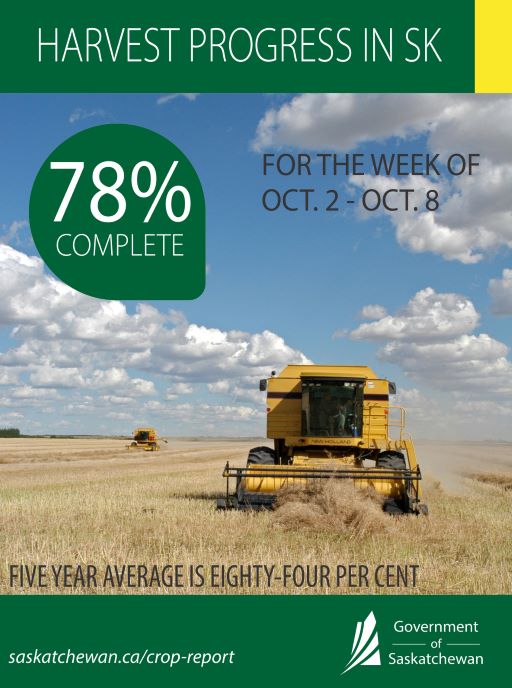Released on October 11, 2018
Many producers were able to return to the field last week. Seventy-eight per cent of the crop is now in the bin, up from 73 per cent last week but behind the five-year (2013-17) average of 84 per cent for this time of year.
Wet and cool weather continues to slow progress in much of the province.
Harvest has essentially stalled in the northwest, due to a heavy snowfall earlier this week. Many areas reported snow last week, ranging from small amounts to several inches. More warm, dry and windy days are needed before producers can return to the field.
Harvest remains most advanced in the southwest, where 90 per cent of the crop is now combined, and in the southeast, where 89 per cent is combined, but these numbers are unchanged from last week. Producers in the west-central region have 70 per cent of the crop combined and those in the northeast are 64 per cent complete. The east-central region has 63 per cent combined, while the northwestern region has 44 per cent combined.

Eighty-five per cent of durum, 81 per cent of barley, 80 per cent of mustard, 65 per cent of spring wheat, 61 per cent of canola, 36 per cent of flax and 30 per cent of soybeans have now been combined. Many crops are coming off tough or damp and are being placed in dryers.
Topsoil moisture conditions continue to improve with the recent rain and snow. Cropland topsoil moisture is rated as four per cent surplus, 66 per cent adequate, 24 per cent short and six per cent very short. Hay land and pasture topsoil moisture is rated as two per cent surplus, 60 per cent adequate, 29 per cent short and nine per cent very short.
At this time, most livestock producers are indicating they have adequate supplies of hay, straw, greenfeed and feed grain heading into winter. However, producers in southern and central regions are reporting that some areas will have inadequate feed and that shortages are likely.
The majority of crop damage this past week was due to the recent snow and rain lodging crops. There are many reports of geese and other wildlife feeding on swathed crops. Crop quality has been affected, and downgrading is expected at the elevator due to bleaching and sprouting.
A complete, printable version of the Crop Report is available online at http://www.publications.gov.sk.ca/redirect.cfm?p=92029&i=108994.
Follow the 2018 Crop Report on Twitter at @SKAgriculture.
-30-
For more information, contact:
Shannon Friesen
Agriculture
Moose Jaw
Phone: 306-694-3592
Email: shannon.friesen@gov.sk.ca

